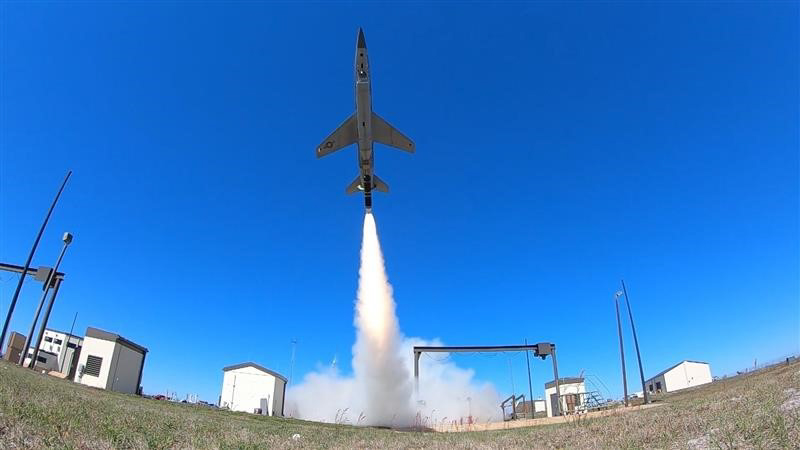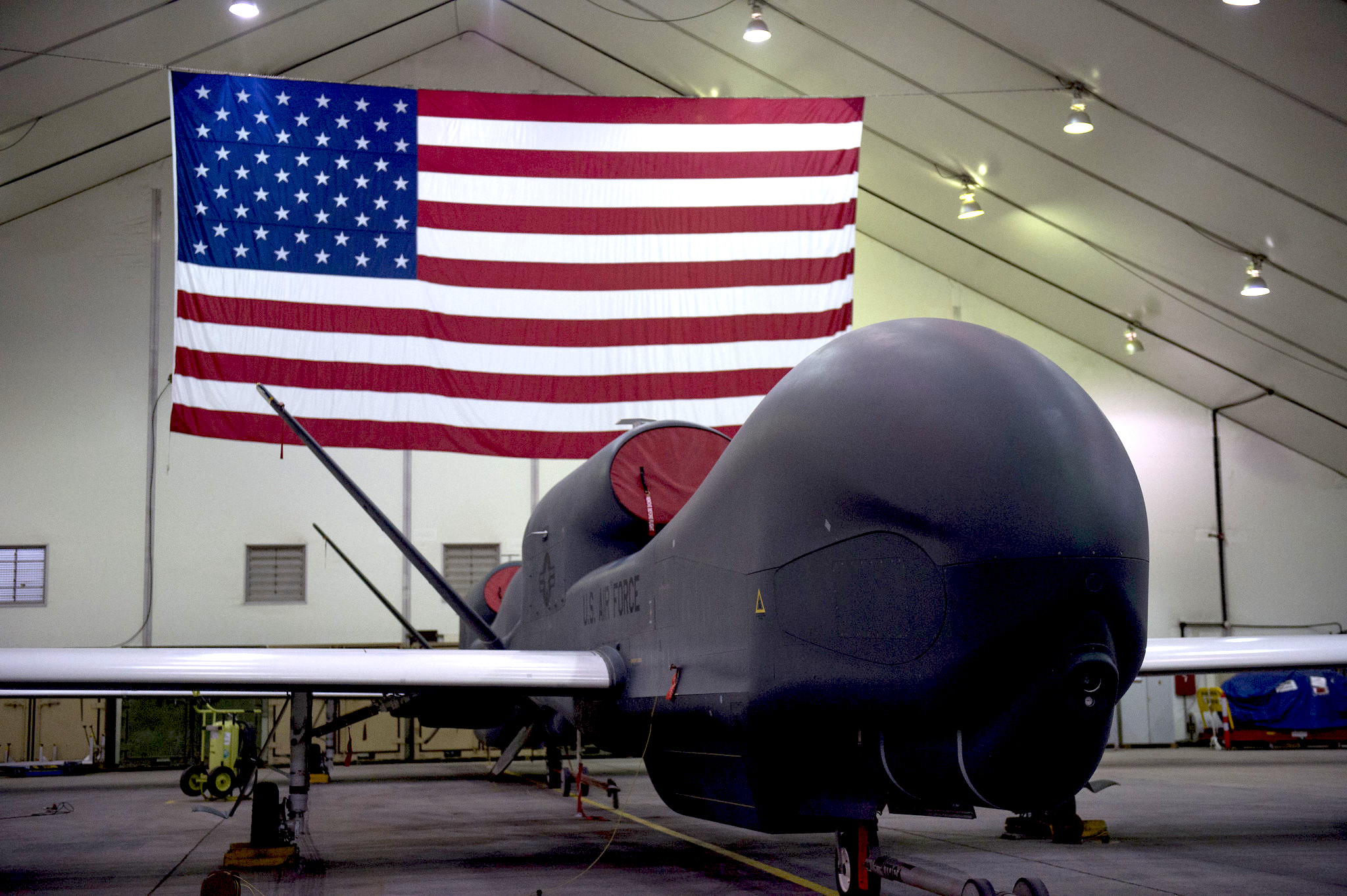The quest for decisive U.S. military superiority over Beijing and the ability to win a war against a nuclear-armed power should be considered a fool’s errand, writes William D. Hartung. But it isn’t.

The Skyborg autonomy core system launches aboard a combat drone at Tyndall Air Force Base in Florida as part of the Pentagon’s “autonomous attritable aircraft” experimentation, April 29, 2021. (U.S. Air Force)
By William D. Hartung
TomDispatch.com
 On Aug. 28, Deputy Secretary of Defense Kathleen Hicks chose the occasion of a three-day conference organized by the National Defense Industrial Association (NDIA), the arms industry’s biggest trade group, to announce the “Replicator Initiative.” Among other things, it would involve producing “swarms of drones” that could hit thousands of targets in China on short notice. Call it the full-scale launching of techno-war.
On Aug. 28, Deputy Secretary of Defense Kathleen Hicks chose the occasion of a three-day conference organized by the National Defense Industrial Association (NDIA), the arms industry’s biggest trade group, to announce the “Replicator Initiative.” Among other things, it would involve producing “swarms of drones” that could hit thousands of targets in China on short notice. Call it the full-scale launching of techno-war.
Her speech to the assembled arms makers was yet another sign that the military-industrial complex (MIC) President Dwight D. Eisenhower warned us about more than 60 years ago is still alive, all too well, and taking a new turn. Call it the MIC for the digital age.
Hicks described the goal of the Replicator Initiative this way:
“To stay ahead [of China], we’re going to create a new state of the art… leveraging attritable, autonomous systems in all domains which are less expensive, put fewer people at risk, and can be changed, upgraded, or improved with substantially shorter lead times… We’ll counter the PLA’s [People’s Liberation Army’s] with mass of our own, but ours will be harder to plan for, harder to hit, and harder to beat.”
Think of it as artificial intelligence (AI) goes to war — and oh, that word “attritable,” a term that doesn’t exactly roll off the tongue or mean much of anything to the average taxpayer, is pure Pentagonese for the ready and rapid replaceability of systems lost in combat. Let’s explore later whether the Pentagon and the arms industry are even capable of producing the kinds of cheap, effective, easily replicable techno-war systems Hicks touted in her speech. First, though, let me focus on the goal of such an effort: confronting China.
Target: China
However one gauges China’s appetite for military conflict — as opposed to relying more heavily on its increasingly powerful political and economic tools of influence — the Pentagon is clearly proposing a military-industrial fix for the challenge posed by Beijing.
Taiwan's Ministry of Defense just published a handy guide to US military bases in the region circa 2023. Media outlets might consider including this helpful visual context in their China-related coverage pic.twitter.com/GslgEyI8Qt
— Michael Tracey (@mtracey) September 12, 2023
As Hicks’ speech to those arms makers suggests, that new strategy is going to be grounded in a crucial premise: that any future technological arms race will rely heavily on the dream of building ever cheaper, ever more capable weapons systems based on the rapid development of near-instant communications, artificial intelligence, and the ability to deploy such systems on short notice.
The vision Hicks put forward to the NDIA is, you might already have noticed, untethered from the slightest urge to respond diplomatically or politically to the challenge of Beijing as a rising great power. It matters little that those would undoubtedly be the most effective ways to head off a future conflict with China.
Such a non-military approach would be grounded in a clearly articulated return to this country’s longstanding “One China” policy. Under it, the U.S. would forgo any hint of the formal political recognition of the island of Taiwan as a separate state, while Beijing would commit itself to limiting to peaceful means its efforts to absorb that island.
There are numerous other issues where collaboration between the two nations could move the U.S. and China from a policy of confrontation to one of cooperation, as noted in a new paper by my colleague Jake Werner of the Quincy Institute:
“1) development in the Global South; 2) addressing climate change; 3) renegotiating global trade and economic rules; and 4) reforming international institutions to create a more open and inclusive world order.”
Achieving such goals on this planet now might seem like a tall order, but the alternative — bellicose rhetoric and aggressive forms of competition that increase the risk of war — should be considered both dangerous and unacceptable.
On the other side of the equation, proponents of increasing Pentagon spending to address the purported dangers of the rise of China are masters of threat inflation. They find it easy and satisfying to exaggerate both Beijing’s military capabilities and its global intentions in order to justify keeping the military-industrial complex amply funded into the distant future.
As Dan Grazier of the Project on Government Oversight noted in a December 2022 report, while China has made significant strides militarily in the past few decades, its strategy is “inherently defensive” and poses no direct threat to the United States. At present, in fact, Beijing lags behind Washington strikingly when it comes to both military spending and key capabilities, including having a far smaller (though still undoubtedly devastating) nuclear arsenal, a less capable Navy and fewer major combat aircraft. None of this would, however, be faintly obvious if you only listened to the doomsayers on Capitol Hill and in the halls of the Pentagon.
But as Grazier points out, this should surprise no one since “threat inflation has been the go-to tool for defense spending hawks for decades.”

“Global Hawk” unmanned surveillance aircraft at an undisclosed location in Southwest Asia, April 2016. (DoD, Adrian Cadiz)
That was, for instance, notably the case at the end of the Cold War of the last century, after the Soviet Union had disintegrated, when then chairman of the Joint Chiefs of Staff Colin Powell so classically said:
“Think hard about it. I’m running out of demons. I’m running out of villains. I’m down to [Cuba’s Fidel] Castro and Kim Il-sung [the late North Korean dictator].”
Needless to say, that posed a grave threat to the Pentagon’s financial fortunes and Congress did indeed insist then on significant reductions in the size of the armed forces, offering less funds to spend on new weaponry in the first few post-Cold War years.
Donate to CN’s Fall Fund Drive
But the Pentagon was quick to highlight a new set of supposed threats to American power to justify putting military spending back on the upswing. With no great power in sight, it began focusing instead on the supposed dangers of regional powers such as Iran, Iraq and North Korea. It also greatly overstated their military strength in its drive to be funded to win not one but two major regional conflicts at the same time. This process of switching to new alleged threats to justify a larger military establishment was captured strikingly in Michael Klare’s 1995 book Rogue States and Nuclear Outlaws.
After the 9/11 attacks, that “rogue states” rationale was, for a time, superseded by the disastrous “Global War on Terror,” a distinctly misguided response to those terrorist acts. It would spawn trillions of dollars of spending on wars in Iraq and Afghanistan and a global counter-terror presence that included U.S. operations in 85 — yes, 85! — countries, as strikingly documented by the Costs of War Project at Brown University.
All of that blood and treasure, including hundreds of thousands of direct civilian deaths (and many more indirect ones), as well as thousands of American deaths and painful numbers of devastating physical and psychological injuries to U.S. military personnel, resulted in the installation of unstable or repressive regimes whose conduct — in the case of Iraq — helped set the stage for the rise of the Islamic State (ISIS) terror organization.
As it turned out, those interventions proved to be anything but either the “cakewalk” or the flowering of democracy predicted by the advocates of America’s post-9/11 wars. Give them full credit, though. They proved to be a remarkably efficient money machine for the denizens of the military-industrial complex.
Constructing the ‘China Threat’

China’s Ministry of National Defense compound, aka the August 1st Building, in Beijing, 2006. (Netson, Wikimedia Commons, CC BY-SA 4.0)
As for China, its status as the threat du jour gained momentum during the years of former President Donald Trump. In fact, for the first time since the 20th century, the Pentagon’s 2018 defense strategy document targeted “great power competition” as the wave of the future.
One particularly influential document from that period was the report of the congressionally mandated National Defense Strategy Commission. That body critiqued the Pentagon’s strategy of the moment, boldly claiming (without significant backup information) that the Defense Department was not planning to spend enough to address the military challenge posed by great power rivals, with a primary focus on China.
The commission proposed increasing the Pentagon’s budget by 3 percent to 5 percent above inflation for years to come — a move that would have pushed it to an unprecedented $1 trillion or more within a few years. Its report would then be extensively cited by Pentagon spending boosters in Congress, most notably former Senate Armed Services Committee Chair James Inhofe (R-OK), who used to literally wave it at witnesses in hearings and ask them to pledge allegiance to its dubious findings.
That 3 percent to 5 percent real-growth figure caught on with prominent hawks in Congress and, until the recent chaos in the House of Representatives, spending did indeed fit just that pattern.
What has not been much discussed is research by the Project on Government Oversight showing that the commission that penned the report and fueled those spending increases was heavily weighted toward individuals with ties to the arms industry. Its co-chair, for instance, served on the board of the giant weapons maker Northrop Grumman, and most of the other members had been or were advisers or consultants to the industry, or worked in think tanks heavily funded by just such corporations. So, we were never talking about a faintly objective assessment of U.S. “defense” needs.
Beware of Pentagon ‘Techno-Enthusiasm’

Kathleen Hicks speaking at the Pentagon in June. (DoD, John Wright)
Just so no one would miss the point in her NDIA speech, Hicks reiterated that the proposed transformation of weapons development with future techno-war in mind was squarely aimed at Beijing. “We must,” she said,
“ensure the PRC leadership wakes up every day, considers the risks of aggression and concludes, ‘today is not the day’ — and not just today, but every day, between now and 2027, now and 2035, now and 2049, and beyond… Innovation is how we do that.”
The notion that advanced military technology could be the magic solution to complex security challenges runs directly against the actual record of the Pentagon and the arms industry over the past five decades. In those years, supposedly “revolutionary” new systems like the F-35 combat aircraft, the Army’s Future Combat System (FCS), and the Navy’s Littoral Combat Ship have been notoriously plagued by cost overruns, schedule delays, performance problems, and maintenance challenges that have, at best, severely limited their combat capabilities. In fact, the Navy is already planning to retire a number of those Littoral Combat Ships early, while the whole FCS program was canceled outright.
In short, the Pentagon is now betting on a complete transformation of how it and the industry do business in the age of AI — a long shot, to put it mildly.

U.S. Secretary of Defense Lloyd Austin, third from right, during a drone demonstration in Kenya on Sept. 26. (DoD, Alexander Kubitza)
But you can count on one thing: the new approach is likely to be a gold mine for weapons contractors, even if the resulting weaponry doesn’t faintly perform as advertised. This quest will not be without political challenges, most notably finding the many billions of dollars needed to pursue the goals of the Replicator Initiative, while staving off lobbying by producers of existing big-ticket items like aircraft carriers, bombers, and fighter jets.
Members of Congress will defend such current-generation systems fiercely to keep weapons spending flowing to major corporate contractors and so into key congressional districts. One solution to the potential conflict between funding the new systems touted by Hicks and the costly existing programs that now feed the titans of the arms industry: jack up the Pentagon’s already massive budget and head for that trillion-dollar peak, which would be the highest level of such spending since World War II.
The Pentagon has long built its strategy around supposed technological marvels like the “electronic battlefield” in the Vietnam era; the “revolution in military affairs,” first touted in the early 1990s; and the precision-guided munitions praised since at least the 1991 Persian Gulf war.
It matters little that such wonder weapons have never performed as advertised. For example, a detailed Government Accountability Office report on the bombing campaign in the Gulf War found that
“the claim by DOD [Department of Defense] and contractors of a one-target, one-bomb capability for laser-guided munitions was not demonstrated in the air campaign where, on average, 11 tons of guided and 44 tons of unguided munitions were delivered on each successfully destroyed target.”
When such advanced weapons systems can be made to work, at enormous cost in time and money, they almost invariably prove of limited value, even against relatively poorly armed adversaries (as in Iraq and Afghanistan in this century).
China, a great power rival with a modern industrial base and a growing arsenal of sophisticated weaponry, is another matter. The quest for decisive military superiority over Beijing and the ability to win a war against a nuclear-armed power should be (but isn’t) considered a fool’s errand, more likely to spur a war than deter it, with potentially disastrous consequences for all concerned.
Perhaps most dangerous of all, a drive for the full-scale production of AI-based weaponry will only increase the likelihood that future wars could be fought all too disastrously without human intervention.
As Michael Klare pointed out in a report for the Arms Control Association, relying on such systems will also magnify the chances of technical failures, as well as misguided AI-driven targeting decisions that could spur unintended slaughter and decision-making without human intervention. The potentially disastrous malfunctioning of such autonomous systems might, in turn, only increase the possibility of nuclear conflict.
It would still be possible to rein in the Pentagon’s techno-enthusiasm by slowing the development of the kinds of systems highlighted in Hicks’ speech, while creating international rules of the road regarding their future development and deployment. But the time to start pushing back against yet another misguided “techno-revolution” is now, before automated warfare increases the risk of a global catastrophe. Emphasizing new weaponry over creative diplomacy and smart political decisions is a recipe for disaster in the decades to come. There has to be a better way.
William D. Hartung, a TomDispatch regular, is a senior research fellow at the Quincy Institute for Responsible Statecraft and the author of Profits of War: Corporate Beneficiaries of the Post-9/11 Surge in Pentagon Spending (Brown University’s The Costs of War Project and the Center for International Policy, September 2021).
This article is from TomDispatch.com.
The views expressed are solely those of the author and may or may not reflect those of Consortium News.
Donate to CN’s
Fall Fund Drive



Hubris in another flavor–but not so very different–ach, these ideas so typical, so odd.
Persistent error–_idee fixe_ warrant, unidentified assumption–usually come out of misapplication of experience–early experience, traumatic experience, but also experience generally. With respect to a lot of things, lots of us have this idea that the tech is going to save us in one or another sort of “silver bullet” way. But no.
It’s not that the technology makes no difference–far from it. But the key thing, outside of just not blowing ourselves to Kingdom Come, is that different technology effects us in that it requires another sort of social ergonomics to operate. And a new ergonomics means a fresh equilibrium, or disequilibrium.
For this reason, technoczars all over, and particularly in the inordinately czarist West, amend and reproduce these technological and informational infrastructures to suit their moribund and dysfunctional assemblies of power.
Accordingly, appropriate technology has to mean technology that a population can handle. That means open information, gardening tools and not swords, and so forth. The power centers of our society are worse than useless at this point, and any support for them drains the vigor of the system in order to produce its poison.
The true power that runs and controls the US via its unsurpassed military might must continue their war agenda in order to justify their insane and wasteful military budget and to probe up the MIC to continue amassing obscene profits producing the weapons of death. The US is the most warlike nation in the history of the world. The American regime has to create an imaginary enemy in order to justify its ever expanding military budget. Any sane person knows that China is not planning to attack the US, or has the resources and capabilities to do so. Therefore, for the US to prepare for war on China is a mad man’s decision. This is a most irresponsible and incomprehensible act. If the US continues on this war spending and war mongering trajectory, this nation will not only bankrupt itself eventually but it will lead to national economic, social, moral and political ruin. This madness must be stopped immediately. The priorities of the US government are geared towards destruction and death instead of construction and development. There is a dire need to resolve the nation’s huge income disparity, crumbling infrastructure, failing education system, massive drugs problems, toxic political climate, environmental degradation, climate change, failing manufacturing competitiveness, and many other domestic issues. The US government will do well to focus on these matters instead of wasting money on bombing and destroying other countries. The US is most certainly NOT a force for global good.
The military industrial protection racket over over the millennia since the Roman Empire for cultural superiority and warfare technology must be reigned in for human civilization to survive. Their profit motives mixed with cultural prophet motives are an existential threat to collective human civilization on this planet now with a self created god complex for permission.
To be honest, so far the human decisions scare me enough that I’m not sure AI’s can get much worse. Lets recall some examples.
— An American cruiser in the Persian Gulf shot down a civilian Iranian airliner, killing hundreds of innocent souls. It was done apparently under the hallucination that this airliner was maneuvering as if it was a jet warplane on an attack vector.
— An American missile scored a direct hit on a bomb shelter in Baghdad killing hundreds of souls. This time the hallucination was said to be that this bunker was Saddam’s secret HQ, despite the hundreds of civilians obviously going into it every time the air raid sirens blared.
–This is the anniversary of the attack on the civilian hospital in Kunduz, Afghanistan. Where an American flying gunship, the sort with a 3 or 4 inch cannon firing out the side of the plane, along with a broadside of other deadly weapons, fired for 30 minutes while circling the hospital. Apparently using the giant red-cross as a target. What the heck they were thinking, I can not imagine.
And I’m supposed to be afraid of AI’s making bad decisions that kill lots of innocent people?
Is an actual machine more dangerous than a human who is trained and conditioned to think and react like a machine?
I’m waiting for the American people to wake up to the fact that it is all a giant con. The one thing that is obvious on the battlefield, and thus hidden from Americans, is that these mega-expensive, super-weapons really ain’t so super.
The ‘Defense industry’ used to get busted for $1000 toilet seats, but for the last 20 years the Congress has just been throwing money at them, giving them even more than they even think to ask for, with ‘oversight’ being a dirty word. So, given human nature, just how honest do you think these ‘patriots’ have been at giving the taxpayer their true money’s worth?
There’s the legend of the Empress and her New Clothes. But, we are going to need another about the Knight who went forth to do battle thinking they were invincible because of the New Weapons that had been sold to him.
But, if you keep voting for more “Strong” candidates, you just going to keep paying for more New Weapons to replace the Old Weapons which failed. The only difference of course is that the price gets raised and they put a ‘New!’ sticker on the windshield, and have another drink paid for by the suckers.
It’s all about the Benjamins. The MICIMATT cannot produced inexpensive weapons. It is not in its DNA. China is not aggressive. It is the enemy of the day, the week, du jour, the year. … Take your pick. Did we not have wundewaffen to defeat the Taliban, the Iraqis, the Syrians. The air force has nothing but old aircraft and the hanger queen F-35. The Navy its carrier battle groups or the fattest targets you ever saw. The Army? the Marines? who fills the ranks. How do you transport them and their equipment n this age of competent missile technology.
As long as the “defense” industries are producing for sales and maximum profit for the executive suite and the shareholders (hedge funds?), there will be little actual defense.
Good to know: If you are on your phone talking to your Best Friend Forever about the shoes that you just saw on sale down at the mall, FEMA will not unduly inconvenience you with warnings about the launching of missiles and Global Nuclear War and your impending doom. Today’s nationwide-emergency test of the system did not interrupt phone calls, so the people who were talking on the phone did not get the test alert.
The technological age has overall been an unmitigated disaster for the natural world which includes all its inhabitants. Time to reverse course before we head further down this road to oblivion. That would no doubt require a shift away from capitalism: the driver of this continuous destruction.
Couldn’t agree more Lois. But reversing course will take a miracle. (Or a devasting world-wide event)
Since we’re already $33T in the hole, where is all this money going to come from? Are we going to have a massive purchase of rolls of toilet paper for the US mint? The USG reminds me of Jay Leno who, hyping doritos in an ad said, eat all you like we’ll make more. We can print all the dollars you like but will anybody take ’em? There be the monster of inflation….
Remember that all of that Bailout money handed out by the government was in the forms of loans to big corporations. Loans do not have a COLA, so it is the benefit of the corporations if ‘monster inflation’ shrinks the value of the dollars that they eventually have to repay the government. The payments are locked in, to the cent, and do not adjust with inflation.
With high enough inflation, a corporate restaurant chain might repay their bailout loan with pre-set payments per the coupon book, while charging you $400 for a hamburger due to inflation. The same also works for much of the US Government debt. They have some inflation-adjusted bonds, but most of those 10-year Treasuries are not inflation adjusted. The purchaser gets a set amount on each payment date, whether its currently worth enough for even a cup of coffee or not.
Inflation is a means of writing down existing debt, but making ordinary people pay for it by higher prices.
I doubt that the mindset of Washington D.C. will change its thinking about MIC spending because there is so much of it coming back into the hands of incumbent politicians. For average Americans our best chance for a materially downsized Department of War is that they simply run out of money due to a Trillion dollar annual cost to service the debt. Our empire most certainly has peaked and is in decline so its just a matter of time that even the Deep Staters realize we can’t afford a military that costs US taxpayers the same amount as the next 9 largest militaries in the world.
And ushers in the end goal, a Fourth Reich of a thousand years. You will be culled.